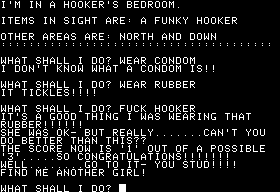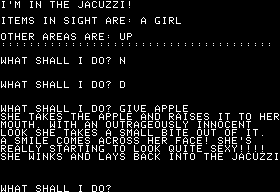As I mentioned at the end of my last post, Softporn has to be among the most discussed and least played games of all time. The idea of it — and of course that iconic cover photo, and the stories behind that — is such an interesting jumping-off point that one can easily forget to even boot the simple text adventure at the root of it all. But I strive to give you more here at The Digital Antiquarian, so I played through the game in all its raunchy entirety. I expected that to be a bit of a chore, but turned out to be rather pleasantly surprised — and no, it wasn’t all down to the sex.
The game begins, as any good sex romp should, in a sleazy bar.
The screenshot above, with the screen divided into a window for the room description and a window for all other text, plainly shows Softporn‘s main influence, the Scott Adams adventures. The prose likewise trends more toward Adams’s lazy exuberance than, say, Infocom’s comparative polish. Still, Benton had the luxury of working with 48 K of memory to Adams’s 16 K, and also had a disk drive to fetch text from a file during play. These factors let him include far more text than Adams could ever manage, and thus to surpass his influence in crafting a more full-bodied (if still very comedic) virtual world.
As long as we’re making comparisons: if you’re familiar with the original Leisure Suit Larry, this scene, along with much else, will look somewhat familiar, what with Larry having been loosely modeled on Softporn. I don’t want to read Softporn entirely through the lens of Larry, but some comparison feels unavoidable. Larry was a very strongly characterized protagonist, a (lovable?) loser who couldn’t seem to unstick himself from the Age of Disco. Softporn is different, and not just because, in keeping with its era and inspirations, its hero is only cursorily characterized as the player’s “puppet” (a word lifted straight from Scott Adams). Softporn, you see, is itself a product of nightclub culture at the tail-end of the disco era. It does state in the manual that “the year is 2020 A.D.,” and the game makes the occasional halfhearted stab at reflecting a futuristic dystopia, most notably via a series of ultra-violent programs available for viewing on a television. But still, the milieu that is in Larry a cheesy obsession of the hopelessly unhip protagonist is here just everyday life. There was after all a time when the hip and beautiful people really did wear polyester leisure suits. Softporn is from that time, and something of a time capsule of the late disco era, best experienced with a little Chic playing in the background.
Chuck Benton says today that parts of the game were drawn straight from his own experiences, although he’s not telling exactly which parts. There’s almost always an element of real, if exaggerated, lived experience to its humor that makes at least some of us laugh and wince at the same time. For instance, every suburban boy’s worst nightmare plays out when you try to buy a condom in the drugstore.
This gag also got recycled for Leisure Suit Larry, but there it’s something that happens at Larry’s expense; here it feels like it’s really happening to us. (Or is that just the childhood trauma speaking?)
And here we come to something that really surprised me: I found Softporn really, genuinely funny. Yes, it’s all very much guy humor, and not exactly sophisticated stuff… but (and much to my wife’s dismay) I still find Beavis and Butthead about the funniest thing ever, so that kind of humor suits me just fine.
Softporn as a whole is much better than I expected it to be. It’s actually very fair. There are no absurd puzzles here, no parser games, not even any mazes or tangled geography. Yes, it’s written in BASIC and uses a two-word parser, with all the limitations those things imply, but Softporn does a shockingly good job of playing within its limitations and delivering a good time regardless. The puzzles stay simple, never straining the technology beyond its breaking point, and wherever the limited parser does necessitate an unusual syntax, the game bends over backward to make the player aware of it, even at the risk of spoiling puzzles. While it is very possible to die, even the deaths are usually clued in a way that just wasn’t normally done in this era.
Even many years later Leisure Suit Larry would not be so kind in warning about this danger and others. Anyone designing an old-school text adventure today using a limited engine — and for better or for worse, I know you’re out there — could do worse than to have a look at Softporn. I’m amazed to be saying this, but at least in design terms it’s the most fair, modern-feeling text adventure I’ve looked at for these history posts. Yes, more so even than Zork. Partly this is likely due to the development process Benton used; he would let a few of his buddies play the game every weekend or so, collecting their feedback and asking which puzzles worked — and were solvable — and which did not, a seemingly commonsensical step that the majority of old-school developers neglected entirely. And partly it was just down to a forward-looking design philosophy that held “100 simple puzzles better than 1 killer.” The biggest complaint one might level against Softporn‘s design in the context of its time is its brevity. Even approached completely cold as I did, sans prior knowledge, hints, or walkthrough, one is unlikely to get more than two or three hours out of the game. Today that’s of course fine; in 1981, after having paid $30 for the experience, one might be a bit upset. As I’ve pointed out before, commercial concerns often pulled against good design.
So, yes, Softporn is a very likable game. Which isn’t to say that its mind isn’t in the gutter. It soon becomes clear that the goal is to score with three different women in one night (which sounds like quite a tax on a man’s stamina, but then I’m not in my twenties anymore), ascending in desirability from a rough hooker to a girl-next-door type who — fantasy or nightmare, take your pick — turns out to be a dominatrix to an exotic goddess. Thus Ken Williams’s choice to feature three women in his cover photo, although presumably they weren’t told which woman represented which from the game…
As you can see above, the actual sex is pretty much left to the imagination; staying period specific, Softporn is very much Porky’s rather than Debbie Does Dallas. Most of the offensiveness, such as it is, rather comes from dirty words and lots and lots of innuendo, leaving the actual moments of truth as anticlimaxes. We get Biblical for the final (anti)climax.
But at least the game ends before the rest of the story of Eve and the apple (and children and a mortgage) set in.
Ken Williams published Softporn knowing full well it was likely to provoke some controversy, and he wasn’t disappointed. Many of the more conservative residents of Coarsegold and Oakhurst, who had been suspicious of this gang of newcomers from the start, now found all of their initial prejudices amply confirmed. Other sensitive souls from around the country expressed their opinions in hate mail — according to Steven Levy “some of it full of Bible scripture and prophecy of the damnation ahead.” But for the most part the controversy worked as Ken had hoped it would, getting On-Line and entertainment software in general noticed outside of the still tiny ghetto of active Apple II gamers. People in general might not have really understood the burgeoning PC revolution yet, but they all understood what sex was. A story went out over the UPI wire, and, best of all, the game and its cover photo were featured in a Time magazine story on this new concept of selling “Software for the Masses.” (The magazine felt it had to start with the very basics: “The programs, which are mainly recorded on vinyl discs about the size of a 45 r.p.m. record, are instructions written in a mathematical code the machine can ingest.”) With publicity like this, Softporn sold. It sold very well.
At the same time as it was getting such welcome mainstream exposure, though, Softporn is oddly absent from the computer press of the period. Most computer magazines, which were widely read by teens and preteens and whose editors had nightmares of outraged letters from parents, mentioned Softporn cursorily if at all. Computer retailers were also spooked. From Hackers:
Computer stores that wanted it would be reluctant to order just that one program. So, like the teenager who goes to the drugstore and says, “I’d like a comb, toothpaste, aspirin, suntan oil, stationary, and, oh, while I’m here I might as well pick up this Playboy,” the store owners would order a whole sampling of On-Line products… and some Softporn too.
Of course, the same scenario played out again with the customers who frequented those stores; they would sandwich Softporn in amongst other games or more “serious” software before making their way to the checkout stand, another scenario ironically reminiscent of the drugstore scene from within the game itself. Ken estimated Softporn and all the associated sales of “toothpaste” software that it generated to have doubled On-Line’s sales for a time, and some sources estimate Softporn alone to have topped 50,000 in sales over its commercial lifetime, an absolutely huge number for this period. There’s probably a nice discussion of shifting social mores between then and now to be had in all this, but I’ll leave that as an exercise for the reader.
Chuck Benton, a very modest, unassuming sort of fellow, became a celebrity of sorts within Apple II circles, with people even flagging him down to ask for autographs. His mother was left aghast by the Time article in particular, but such is the life of a purveyor of naughty software. And there were plenty of upsides in addition to the big royalty checks On-Line was soon sending him. He started to have more luck with women as a result of the game; after all, he had asked for it.
But always in videogames, as in any creative industry, the question quickly becomes what will you do next. A fair amount of customers had actually written in asking for a female version, which if nothing else proves that at least some women as well as men were buying Apple IIs by this point. However, Benton, for obvious reasons, didn’t feel quite up to the task. He hunted about for a female collaborator to help him get the tone right, and even told Time that a female version was forthcoming when interviewed for their article, but Benton never found the right person and never really got the project started. Another idea, for more of a straight-up sequel that took place at a university and was inspired by Animal House, likewise went nowhere. Benton rather worked for On-Line for a few years as a programmer for hire rather than a designer, doing action games such as Frogger, B.C.’s Quest for Tires, and Micky Mouse’s Space Adventure. Yet Benton, very much a New England boy, never quite fit in with the laid-back California culture of On-Line. Having gotten into all of this as something of a lark, Benton was never hugely passionate about games as a long-term career choice in the first place, and as time went on and marketing budgets increased in relation to development budgets, he became increasingly dissatisfied with the game industry in general. He dropped out circa 1985 to found Technology Systems, Inc., which does research and development work, often for the military, to this day.
If you’d like to play Softporn yourself, I’ve got sort of a special treat for you: the original Blue Sky software release and its accompanying documentation. Thanks go to Howard Feldman’s amazing Museum of Computer Adventure Game History for the latter.
Oh, and before we leave Benton and Softporn, here’s a final piece of trivia for all techno-thriller fans. Long before he published The Hunt for Red October and went from mild-mannered insurance salesman to bestselling author, Tom Clancy was acquainted with Chuck Benton. Jones, the quirky sonar operator from that book, “knew a few people from college who drew up game programs for personal computers; one of them was making good money with Sierra On-Line Systems…” Well, that anecdote was inspired by none other than Chuck Benton.
But next we’ll leave all this sex stuff behind and get back into the dungeon where nerds like us feel most comfortable. No, not that kind of dungeon. Sheesh…





































